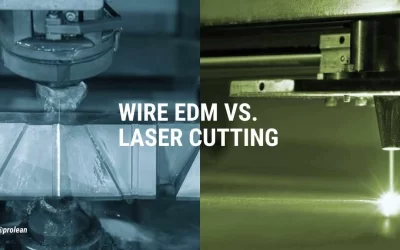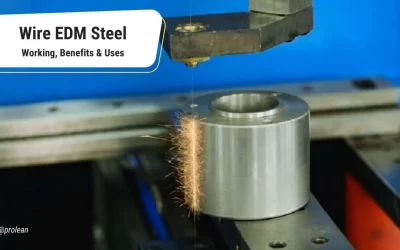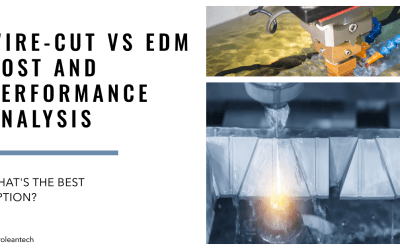CAPABILITIES
Wire Cut/Wire EDM Service
Our wire cut/wire EDM services can provide high precision tolerances, as tight as ±0.0002″ for an array of industries and applications.
- Tolerances down to ±0.0002″ (0.005mm)
- Parts as Fast as 3 days
- Aluminium, Steel, Copper, Polymers & More





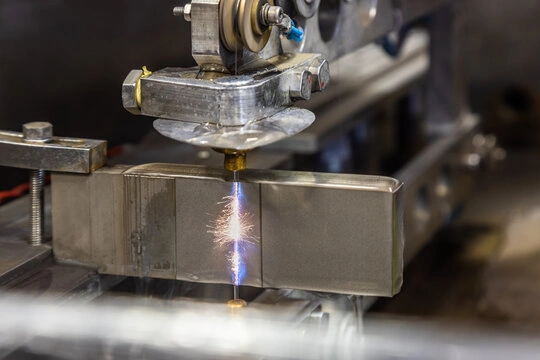
All uploads are secure and confidential.
Our Wire EDM Service
Prolean’s Wire EDM service excels in precision manufacturing:
- Precision: Cuts with tolerances up to 2µm(0.0001”) using thin wires.
- Complexity: Handles intricate shapes unachievable by standard methods.
- Expertise: Over a decade of high-quality production.
- Microwire Capability: Uses wires as thin as 20µm(0.0008″) for exact cuts and repeatability.
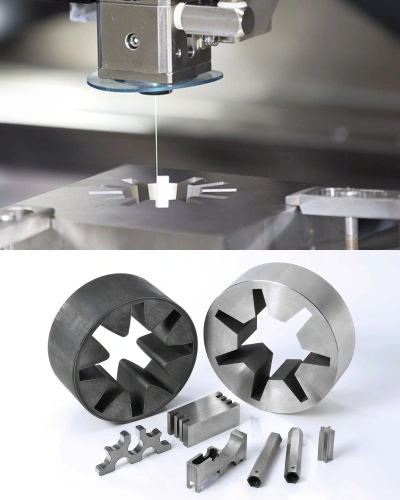
Try Prolean Now!
How Does Wire Cut Machining Work?
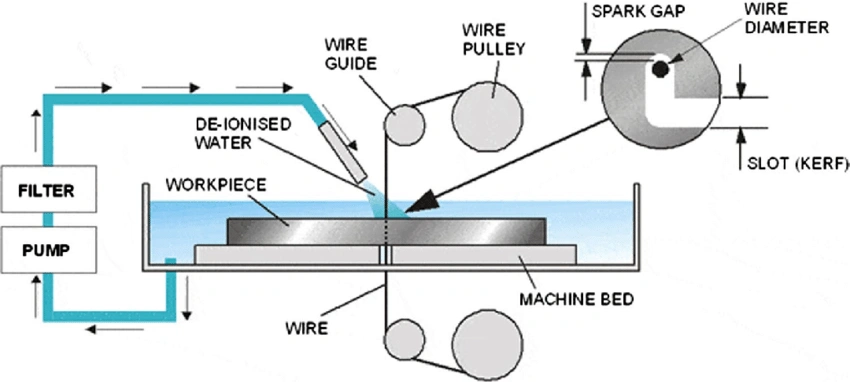
Wire EDM machining employs a thin brass wire and high voltage to cut materials without direct contact:
- Sparks: Generates sparks to melt metal without touching the workpiece.
- Fluid Control: Uses a special fluid to regulate charges and remove molten metal.
- Precision Cutting: Guides the wire for intricate cuts unachievable with conventional CNC.
- Clean Cuts: Fluid cleans the cutting area for precise, clean results.
Wire EDM Machining Materials
| Material | Cuttability | ToleranceRange |
| Tool Steel | Excellent | +0.005 mm |
| Stainless Steel | Very Good | +0.005 mm |
| Aluminum | Good | +0.006 mm |
| Conductive Plastic | Fair | ±0.01 mm |
| Conductive Ceramic | Limited | ±0.01 mm |
| Material | ToleranceRange |
| Tool Steel | +0.005 mm |
| Stainless Steel | +0.005 mm |
| Aluminum | +0.006 mm |
| Conductive Plastic | ±0.01 mm |
| Conductive Ceramic | ±0.01 mm |
Metal wire cutting: Metals often have high melting points, making them a good fit for wire cutting, as the method doesn’t require significant heat.
- Best Application: Producing intricate shapes on hardened steels, making tools, dies, and punches.
Plastic wire cutting: Certain plastics can also be wire cut, especially if they are electrically conductive. The finish is usually smooth.
- Best Application: Manufacturing insulative components with detailed profiles or slots.
Advantages of Wire EDM

- Production Efficiency
Prolean’s wire-cutting process excels in productivity and delivers high-quality surfaces that usually require no further polishing, ensuring the time-efficient and standardized production of precision parts.

- All Metals Capability
Prolean’s wire-cutting service effortlessly cuts through any conductive material, regardless of hardness or brittleness. This versatility covers all metal classes, offering extensive material choices for various applications.

- High Precision
Prolean’s Wire EDM offers exceptional precision, achieving tolerances as fine as 10 millionths of an inch, ideal for complex components requiring strict conformity.

- Low Distortion
Wire EDM machining avoids internal stresses and distortion by not heating, tearing, or impacting the material, ensuring the final product maintains precise dimensions and shape.

- Very Fine Features
Prolean’s Wire EDM excels in crafting intricate two-dimensional designs, with the wire’s flexibility allowing for precise cutting of small features without pressure, enabling detailed small geometries.

- Safe Operation
Prolean’s Wire EDM operates safely at high voltages, allowing for autonomous operation that reduces costs while maintaining high safety and quality standards in production.
Try Prolean Now!
Our Wire Cut Capabilities
|
Category |
Details |
Unique Features |
Applications |
Capacity & Volume |
|
Core Service |
Precision Wire EDM Machining |
High precision and repeatability |
Prototypes, Medium & High-Volume Production |
Up to 100K+ parts |
|
Tolerances |
+/- .0001” |
Extremely tight tolerances |
High-precision components and tooling |
Precision for both small and large production runs |
|
Workpiece Thickness |
Up to 16” |
Versatile handling of various thicknesses |
Parts requiring high-thickness cuts |
Suitable for both thin and thick parts |
|
Complexity |
4-axis & intricate contours |
Capability for complex geometries |
Intricate and detailed parts |
Complex parts and fine features |
|
Cutting Method |
Submerged cutting for thermal stability |
Reduced thermal distortion |
High-precision and high-tolerance cutting |
Efficient cutting with minimal thermal effects |
|
Automation |
Auto-threading |
Enhanced efficiency and reduced downtime |
Continuous production runs |
High-volume production capability |
|
Prototyping |
Quick turnaround for initial designs |
Fast production for prototypes |
Development and testing of new designs |
Speedy prototyping for rapid development |
|
High-Volume Production |
Capability for large-scale manufacturing |
High throughput and consistent quality |
Large-scale manufacturing and continuous production |
Large production runs with consistent precision |
|
Laser Marking |
High-precision part marking |
Durable and clear markings |
Identification and labeling of components |
High-quality marking for traceability and identification |
|
Small Hole EDM |
Precision machining for small holes |
Fine hole accuracy |
Applications requiring small, precise holes |
Ideal for intricate and small-scale applications |
| Category | Details |
| Core Service | Precision Wire EDM Machining |
| Tolerances | +/- .0001” |
| Workpiece Thickness | Up to 16” |
| Complexity | 4-axis & intricate contours |
| Cutting Method | Submerged cutting for thermal stability |
| Prototyping | Quick turnaround for initial designs |
| High-Volume Production | Capability for large-scale manufacturing |
| Laser Marking | High-precision part marking |
| Small Hole EDM | Precision machining for small holes |
How to Order Parts?
Get a free quote from a real engineer; once we receive your design, our engineer will review it and send you a quote as fast as one hour.

Get A Quote Immediately
Upload your design or email our engineer directly and get your quotes as fast as one hour.

Start Production
Your parts will be made once your orders are confirmed. Besides, you will get real-time order updates of the production status from our order tracking system.

Receive Your Part
After all parts pass QC inspection, they will be well packed from transportation accidents. Then, your custom parts are delivered straight to your doorstep.
Wire EDM Machining Applications

Aerospace Industry
Wire EDM is very useful in the aerospace industry to produce complex shapes such as turbine blades, where high tolerances are required. It is also employed in the production of small nozzles, airframes, and intricate engine components where precision is critical and where the parts have to conform to aerospace specifications.
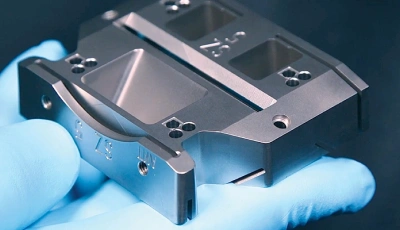
Medical Industry
In the medical industry, Wire EDM is used to manufacture accurate dental implants, surgical tools, and many other tools. The process is most useful when it comes to manufacturing small parts, for instance in dentistry where the parts are very small and intricate.

Manufacturing Industry
Wire EDM is widely applicable in the manufacturing of die for plastic injection molding. It guarantees the right contouring of molds which is very important in the production of large quantities of parts with standard quality. Some examples are complex molds for automobile and consumer products.
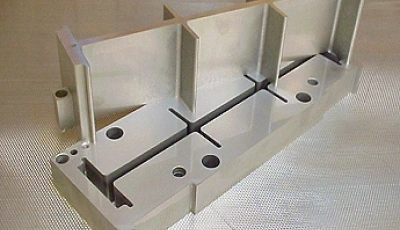
Die & Tooling Industry
Wire EDM is used to create precise components such as punches, dies, cams, gears, and custom die inserts. These parts are essential for high-accuracy stamping and forming operations, ensuring reliable performance in industries like automotive and aerospace.

Electronics Industry
Wire EDM is widely used in the electronics industry where small and accurate parts such as connectors, lead frames, and micro parts are manufactured. These parts are used in the internal circuit boards of electronics and even a slight variation in dimensions can hamper the functionality and durability of the device.
Try Prolean Now!
Wire Cut Machining Gallery
See How Our Customers Dig Us
Their engineers help us from the beginning of the project, whether it is design consultation or helping in the selection of the best machining method. I am happy with wire wire-cut parts you sent me.
-Ethan Crowley, Surface Finishing Manager at MolderTech Prototyping
I just wanted to say thank you to your team for these fuel injector nozzles. I understand the dedication required for the complexity and tough features of my design.
-Sierra Windemere, Tooling Engineer at PrecisionCoat Solutions
The precision and cost-effectiveness of Prolean's wire EDM services are exceptional. Every design you send to them is worth it if you especially need the custom parts.
-Kara Stonebrook, DieCast Dynamics
We recently had a batch of turbine blades manufactured from protean, specified tolerance and finish on these complex components are outstanding. We appreciated the quick turnaround time and attention to detail.
-Jaxon Blackwell, ProtoParts Manufacturing
We had a challenging project involving delicate electronic connectors that required precise cuts and fine details. Then we contacted Prolean their Wire EDM service handled it with expertise, delivering high-quality parts that fit perfectly into our designs.
-Elara Moonstone
For our latest prototype, we were searching for a manufacturer to supply use some custom parts made from high-hardness materials. Our tool supplier recommends Prolean. Very happy with the great support throughout the process provided by Prolean's team.
-Gavin Silverwood
3 Ways to Ensure Perfection
Standards
Metals: ISO-2768 fH (fine)
Plastics: ISO-2768 mK (medium)
Metric threads tolerances: ISO 965-1 standard UN Threads Tolerances: ASME B1.1-2003 standard
Knurling: ISO13444:2012 standard.
Our factory is ISO 9001:2015 certificated
Inspection and Protection
Constant visual inspection conditions
Quantification of cosmetic surface quality
Process requirements
Part cleaning and Protection
Quality Inspection Report
Inspection Confirmation
Dimensional confirmation
Appearance confirmation
Quality documentation
Technology Overview
What is Wire Cut ?
The only difference between a wire cutter and a standard EDM is that a wire cutter uses copper wire electrodes of thickness varying from 0.02 to 0.3 mm. When the material to be cut approaches the copper wire electrode, the electrode’s electrical charge tends to jump over to it, creating the spark needed to cut the material. Here the workpiece should be a conductive metal so that the electrode can produce the spark.
The hardened metal and alloys, which are challenging to cut with other machining operations, are machined using the wire cut method. Because wire cutting entails applying minimal stress and little to no change in mechanical properties, it is also a successful machining technique when consistent mechanical properties are required. In addition, parts with Complex geometries, hard metal with tight tolerance requirement, excellent surface finish, and fine holes are achievable with wire cut CNC machining method.
Working Principle of Wire Cut
A low conductive liquid media (dielectric-fluid) is placed between the wire electrode and the metal to be cut. Next, the electrode wire moves close to the workpiece,
The wire becomes the cathode and the workpiece the anode when the electric supply is turned on. Due to the release of ions from the workpiece and the wire, ions tend to accelerate, increasing their kinetic energy and temperature, which leads the dielectric fluid to conduct. A spark will be produced when there is a potential difference between the electrodes once dielectric fluid starts to conduct electric current. The spark erodes the material from the pre-set position. After that, it moves away along a computer-controlled path.
The movement of the cutting wire is multidimensional, allowing the workpiece to be cut on many faces with a single setup while instructions are being sent through the computer.
The process of Wire Cut
The electrode is accurately positioned by providing coordinate instructions on the CNC machine before processing the wire cut. Since every tool used in CNC wire cutting can detect contact, they all operate using the automatic edge and center locating feature.
The wire does not touch the workpiece during the CNC wire cut process; instead, a spark is produced to carry out the operation. Cutting wire that has been electrically charged will increase the electric field as it approaches the workpiece. When it reaches electrical breakdown, the die-electric material placed between them will spark. The workpiece will then start to degrade as the spark jumps across it. The wire is continuously sent through the operation so its erosion won’t affect the cutting process.
The guide that supports the CNC wire cutting machine can move along three axes and in the x-y plane. The CNC computer controls the workpiece and guides movements.
Wire EDM FAQs
What Is Wire EDM's Cutting Method?
Wire EDM uses a thin, electrically charged wire to cut through conductive materials. The wire is continuously fed through the workpiece, generating sparks that melt and erode the material along the programmed path. This process allows for highly precise cuts without direct contact between the wire and the material.
How Accurate is Wire EDM Machining?
TWire EDM is renowned for its high precision, capable of achieving tolerances as tight as ±0.0001 inches. This high level of dimensional accuracy is ideal for producing complex parts with intricate details, ensuring that even the smallest features meet exact specifications.
Is It Possible To Wire EDM Stainless Steel?
Yes, Wire EDM can machine stainless steel effectively. The process is well-suited for cutting hard materials like stainless steel, providing clean cuts with minimal thermal impact, which helps maintain the material’s integrity with low roughness Ra.
What Is the Difference Between EDM and Wire Cut EDM?
EDM (Electrical Discharge Machining) encompasses various processes that remove material using electrical discharges. Wire Cut EDM is a specific type of EDM that uses a thin wire as the electrode to cut through the material, whereas other EDM processes might use different types of electrodes or techniques for material removal.
What Are the Disadvantages of Wire EDM?
The primary disadvantages of Wire EDM include its slower material removal rate compared to traditional machining methods, and its limitation to only conductive materials. Additionally, the process can be more expensive due to specialized equipment and consumables like the wire(electrode) itself.
Your content goes here. Edit or remove this text inline or in the module Content settings. You can also style every aspect of this content in the module Design settings and even apply custom CSS to this text in the module Advanced settings.
Related Blog
The Ultimate Analysis Between Wire EDM Vs Laser Cutting
Wire EDM cuts thicker sheets, while laser cutting is effective for cutting highly rigid materials.
Wire Cutting Steel: How It Works, Benefits & Uses
Wire EDM steel delivers exceptional dimensional accuracy
Wire Cut VS EDM: Cost and Performance Analysis
Comprehensive guide of wire cut and EDM technologies
Get Your Parts Made Today
All uploads are secure and confidential.

